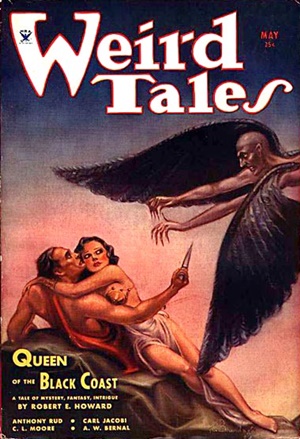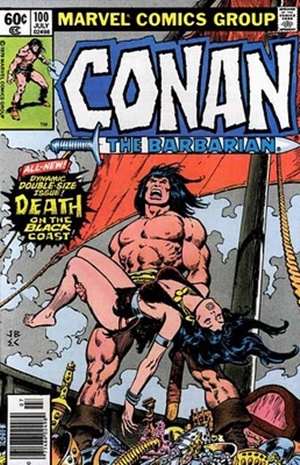Hither Came Conan: Patrice Louinet on “Queen of the Black Coast”
 Robert E. Howard wrote twenty-one tales of Conan, the mighty-thewed Cimmerian. And with today’s entry from Patrice Louinet, Hither Came Conan has looked at all of them: plus, we tossed in “Wolves Beyond the Border” as a bonus! We’ll wrap things up with a summary post. But read on as we close out our examination of the Conan Canon with story that is generally considered to be in the top two or three – when it’s not ranked number one.
Robert E. Howard wrote twenty-one tales of Conan, the mighty-thewed Cimmerian. And with today’s entry from Patrice Louinet, Hither Came Conan has looked at all of them: plus, we tossed in “Wolves Beyond the Border” as a bonus! We’ll wrap things up with a summary post. But read on as we close out our examination of the Conan Canon with story that is generally considered to be in the top two or three – when it’s not ranked number one.
Robert E. Howard’s best Conan tale? Well, it’s a toss between “Beyond the Black River” and “Red Nails,” with a definite leaning for the latter. No way I can say otherwise: I have repeated this over and over, and it’s in print in many places.
And here I am today having to explain why “Queen of the Black Coast” is the best of the Conan tales. Had I been allotted “Vale of the Lost Women,” you would have known I was lying to you, but “Queen”? Luckily for me, “Queen of the Black Coast” is obviously one of the best Conan tales (general consensus), and it also happens to be one of my personal favorites. It contains some very memorable scenes – Conan and Bêlit’s discussion of the afterlife and the gods, most noteworthily – and it addresses in a powerful manner Howard’s theme of the cycle of civilizations:
Conan’s flight from the city to live a barbaric life of piracy only to sail right into the poisonous river that leads to the heart of darkness and the last degenerate survivor of a once-powerful civilization. Powerful stuff in a story that is replete with exquisite – if dark – imagery, and a tragic ending that no one can ever forget. So yes, easily one of the best Conan stories. But not “the best.”
I have been mulling this problem for a while now, and of course, I had the answer all along: “Queen of the Black Coast” is the best Conan tale to read if you have never read any before. In other words, it is the perfect story to discover the character, the Hyborian setting, and of course Howard’s talent.
One of the numerous problems that have plagued the perception of the Cimmerian by the general public is this idea that the tales represent as many steps in Conan’s so-called “biography,” though nothing in the series supports that notion. So, how do you understand a character and his motivations if you have no real biographical background? Well, think James Bond or Dirty Harry and read on.
What do we know about Bond’s or Harry’s life and youth? The answer is simple: nothing. Do we need to? Well, no: we understand how they function as characters through their opening scenes, and that’s exactly all we need to know, because the stories are not about them in the same way the Conan stories are not about Conan. Neither Harry nor Conan really evolve as characters. They are givens, catalysts that put into motion what the story is really about.
Let’s take the example of Sudden Impact, the fourth Dirty Harry movie. We are first introduced to the character’s philosophy though the scene in the elevator, right after a criminal is released because of a technicality. It’s obvious the man is guilty, and Harry froths at the teeth when he confronts the (grinning) man, with a longish monologue that begins with:
“Listen, punk. To me you’re nothin’ but dogshit, you understand? And a lot of things can happen to dogshit.”
The scene is enough in itself to let us know essentials of Callahan’s philosophy, especially as regards the workings of the law. We only need one more scene to fully grasp how he acts on that philosophy, and this takes place right that first scene, when he realizes a robbery is taking place at his favorite diner:
Callahan: Every day for the last 10 years, Loretta gives me a black coffee. Today she gives me a black coffee, but with sugar in it. A lot of sugar. I just came back to complain. Now, you boys put those guns down.
Bad guy: Say what?
Callahan: We’re not just going to let you walk out of here.
Bad guy: Who is “we”, sucker?
Callahan: Smith and Wesson… and me.
(And said scene concludes with what has become the most memorable catchphrase of the series: “Go ahead, punk, make my day.”)
Let’s backpedal 52 years earlier to “Queen of the Black Coast,” and especially its first few pages, leading to his meeting with Bêlit. Two scenes of its opening sequence are mirrored almost exactly in the future Harry movie.
In the first one, the fleeing Cimmerian jumps aboard Master Tito’s ship:
“Who invited you aboard?”
“Get under way!” roared the intruder with a fierce gesture that spattered red drops from his broadsword.
“But we’re bound for the coasts of Cush!” expostulated the master.
“Then I’m for Cush! Push off, I tell you!” […]
“Can you pay for your passage?” demanded the master.
“I pay my way with steel!” roared the man in armor, brandishing the great sword that glittered bluely in the sun. “By Crom, man, if you don’t get under way, I’ll drench this galley in the blood of its crew!”
Conan and his sword clearly anticipates Harry with his Smith & Wesson. It’s all we need to know because, just like Callahan, Conan is a man who lives with his sword, without little regard as to conventions in particular and the accepted codes of civilization in general. The explanation for his flight from the city is explained later, onboard.
“Well, last night in a tavern, a captain in the king’s guard offered violence to the sweetheart of a young soldier, who naturally ran him through. But it seems there is some cursed law against killing guardsmen, and the boy and his girl fled away. It was bruited about that I was seen with them, and so today I was haled into court, and a judge asked me where the lad had gone. I replied that since he was a friend of mine, I could not betray him. Then the court waxed wroth, and the judge talked a great deal about my duty to the state, and society, and other things I did not understand, and bade me tell where my friend had flown. By this time I was becoming wrathful myself, for I had explained my position.”
“But I choked my ire and held my peace, and the judge squalled that I had shown contempt for the court, and that I should be hurled into a dungeon to rot until I betrayed my friend. So then, seeing they were all mad, I drew my sword and cleft the judge’s skull.”
 Once this is established, the reader knows almost everything he needs to know about the Cimmerian’s personality, not about his previous “adventure.” No one is named here – a captain, a sweetheart, a captain, a friend, a judge – and none of these characters will ever be mentioned again. The most important elements are not there, but in a few simple words, that establish the salient traits of the Cimmerian and his philosophy: “who naturally ran him through.” With one adverb, Howard conveys a vast amount of information.
Once this is established, the reader knows almost everything he needs to know about the Cimmerian’s personality, not about his previous “adventure.” No one is named here – a captain, a sweetheart, a captain, a friend, a judge – and none of these characters will ever be mentioned again. The most important elements are not there, but in a few simple words, that establish the salient traits of the Cimmerian and his philosophy: “who naturally ran him through.” With one adverb, Howard conveys a vast amount of information.
Not so much that the young man killed the captain, but that is was the natural thing to do. If someone offends your girlfriend, you kill him, because decent human beings simply do not do that. It also tells us a lot as to how Howard envisions the notion of power: that the man was a captain is essential: it shows us that the Cimmerian has no respect for authority if/once its bearer abuses his position.
“Since he was a friend of mine, I could not betray him” and “seeing they were all mad, I drew my sword and cleft the judge’s skull” proceed from the exact same idea. We now know enough about the character and the real story can begin. There will be other exposition paragraphs in other stories, of course, other memorable catchphrases, but, simply put, you have the essentials for that story. If there’s one thing that Howard was really great at, it’s opening scenes/chapters in his stories.
Another annoying element about the general perception of Conan and the series is Howard’s portrayal of women. None of Howard’s best tales feature any of the cringing damsels in distress that have become so associated with Conan, due mostly to the cover of the first Lancer paperback: a stunning painting by Frank Frazetta, displaying a towering barbaric Conan… and a cringing semi-naked woman, and which was later used as a poster for the Milius movie, setting for decades the visual standard for the Cimmerian.
Frazetta didn’t invent the scene, taking it from one of the (mostly) pot-boiler tales Howard penned when he was in dire need of money. Too bad the volume containing “Queen” was not the first to be published. Reading Howard/Conan for the first time will convince you of one thing: women are never weak creatures born to be protected in the best tales of the series.
Last, but definitely not least, “Queen of the Black Coast” contains one of the most memorable scenes in the entire series, when Conan and Bêlit discuss life and the afterlife:
“Let me live deep while I live; let me know the rich juices of red meat and stinging wine on my palate, the hot embrace of white arms, the mad exultation of battle when the blue blades flame and crimson, and I am content. Let teachers and priests and philosophers brood over questions of reality and illusion. I know this: if life is illusion, then I am no less an illusion, and being thus, the illusion is real to me. I live, I burn with life, I love, I slay, and am content.”
Charles Hoffman, in what was the first essay ever to envision the Conan tales as something more than blood and thunder entertainment, long ago noted how this was essentially a summing up of Conan’s existential philosophy. Yes, the Conan stories are great fun, but they are also food for thought.
And all that could be yours for a mere 25 cents in the May 1934 of Weird Tales!
So, if you have never read any Conan tale before, what are you waiting for? “Queen of the Black Coast” is the best Conan tale… to discover the series.
Prior posts in the series:
Here Comes Conan!
The Best Conan Story Written by REH Was…?
Bobby Derie on “The Phoenix in the Sword”
Fletcher Vredenburgh on “The Frost Giant’s Daughter”
Ruminations on “The Phoenix on the Sword”
Jason M Waltz on “The Tower of the Elephant”
John C. Hocking on “The Scarlet Citadel”
Morgan Holmes on “Iron Shadows in the Moon”
David C. Smith on “The Pool of the Black One”
Dave Hardy on “The Vale of Lost Women”
Bob Byrne on Dark Horse’s “Iron Shadows in the Moon”
Jason Durall on “Xuthal of the Dusk”
Scott Oden on “The Devil in Iron”
James McGlothlin on “The Servants of Bit-Yakin”
Keith West on “Beyond the Black River”
Fred Adams on “The Black Stranger”
Stephen H. Silver on “Man Eaters of Zamboula”
Keith J. Taylor on “Red Nails”
Ryan Harvey on “Hour of the Dragon”
The Animated Red Nails Movie that Never Happened
Mark Finn on “The God in the Bowl”
Bob Byrne on “Rogues in the House”
Bob Byrne on the the Khoraja Saga
Wolfe Deitrich on “Wolves Beyond the Border”
Jeffrey Shanks on “A Witch Shall Be Born”
Deuce Richardson on “Black Colossus”
Next week, we take a final look and wrap things up.
Patrice Louinet is one of the best known names in the world of Conan scholarship. He’s a Robert E. Howard Foundation Award winner and is a member of The Black Circle – the lifetime achievement award. I cited his The Robert E. Howard Guide multiple times in this series, as well as referencing his excellent three-part “Hyborian Genesis” essay, contained in the Del Rey Conans. And then there’s Modiphius’ Conan RPG, the Conan board game from Monolith: you get the idea!
 Bob Byrne’s ‘A (Black) Gat in the Hand’ was a regular Monday morning hardboiled pulp column from May through December, 2018.
Bob Byrne’s ‘A (Black) Gat in the Hand’ was a regular Monday morning hardboiled pulp column from May through December, 2018.
His ‘The Public Life of Sherlock Holmes’ column ran every Monday morning at Black Gate from March, 2014 through March, 2017 (still making an occasional return appearance!).
He organized ‘Hither Came Conan,’ as well as Black Gate’s award-nominated ‘Discovering Robert E. Howard’ series.
He is a member of the Praed Street Irregulars, founded www.SolarPons.com (the only website dedicated to the ‘Sherlock Holmes of Praed Street’) and blogs about Holmes and other mystery matters at Almost Holmes.
He has contributed stories to The MX Book of New Sherlock Holmes Stories – Parts III, IV, V and VI.
And he is in a new anthology of new Solar Pons stories, out now.
Good argument, and a nice finessing of the assignment in light of your on-record views, if something of a minimalist approach. I would have expected a bit more, at least, on the grand passion that gives the story its center and makes the reader care about its two leads. As it is, it feels like we learn more about Dirty Harry than we do about Conan.
Not sure Conan’s background is quite as irrelevant to his character as you would seem to imply, or that his character doesn’t develop. While it’s true Howard wasn’t writing the biography of the Cimmerian later writers attempted to turn the saga into, he did try to keep Conan’s background consistent, just as he did the age in which his protagonist supposedly lived.
The little details on his past with which Howard salts the corpus here and there do help provide additional insight into his personality. And there’s definitely a difference in wisdom and lived experience between the brash young Conan of tales like “The Tower of the Elephant” and the older, more responsible man of “The Phoenix of the Sword,” or even “Black Colossus.” Sure, he’s still instinctive and elemental, but put the older Conan in charge of others and he definitely starts thinking beyond the moment, or himself.
Still, a good note (and story) to go out on, even we we do have the wrap-up to look forward to.
Thank you, Mr. Louinet.
You make a good case for calling “Queen of the Black Coast” the best Conan story to read first. I think there is more to be said about this story, but it would take at least two posts to do justice to everything that Howard packed into this one tale.
Dang, I can’t believe this series over already!
Kudos on explaining why this is the number one Conan story for beginning his grand tales while also admitting it could be the character’s best tale overall…if only you hadn’t gone on record previously declaring otherwise.
I loved your comparison with Bond and Harry, though if truly recommending this tale as the starting point for newbies, I wish you’d carried your thoroughness to the Conan story as well. There’s much heart to the heart of this story, perhaps sharing a glimpse of that would ignite more interest.
I also appreciated your mentions of character arc and the typical Howard Conan female character. While Frazetta gave us memorable and stunning raw beauty, his art has ultimately cornered our Cimmerian like nothing else ever could.
Great post, Patrice!
Jason:
While Frazetta is my favorite artist, I totally agree that his legacy vis a vis Conan is not without its downsides. The power and artistry is there, but his Conan was never particularly accurate. Now, that rendition has been fetishized and totemized, with many artistic derivatives of Frazetta verging on (or stepping clear over to) unintended caricature and parody.
[…] E. Howard (Black Gate): I have been mulling this problem for a while now, and of course, I had the answer all along: […]
[…] E. Howard (Black Gate): I have been mulling this problem for a while now, and of course, I had the answer all along: […]
Deuce, I totally agree. At the panel talk during Howard Days, I said that, while I love Frazetta art and personally would love to have – and truly want – his work to adorn every RBE title, that very same work has pigeonholed Conan et al too much too far too deep…and I don’t know how that is remedied.